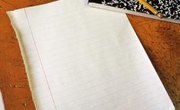Students in higher education often struggle to balance their time between class assignments, extracurricular activities, part-time jobs and an active social life. Using effective critical reading strategies helps students make the most of their study time by aiding comprehension and increasing retention of the most important aspects of a text.
Preview And Summarize
Previewing the text by reading headings and subheadings, bold text, end-of-chapter summaries and discussion questions gives the reader a sense of what the material encompasses. It also gives the reader insight into what areas to pay particularly close attention to while reading. Similarly, summarizing the material after reading helps the reader in recalling the main points of the text. The initial summarizing should be done without the text, referring to it only later to fill in any gaps.
Author's Purpose
Determining why an author wrote the material is an important step in understanding a reading assignment. This is not always obvious at first glace and readers may need to look between the lines to find motivations and connotations not directly stated. Determining this helps students to find and address the deeper meanings of a work, greatly aiding understanding and saving time when working on papers.
Annotating The Text
Highlighting material while reading does not take much critical thinking, and it often is not remembered later why an item was highlighted. Instead of this, Bowling Green State University suggests that students annotate their texts as they read. Writing important words and definitions and numbered points in the margins increases comprehension. The university also suggests writing a question for each paragraph or section that is answered in the material. This critical reading skill will drastically cut down on time when searching for a particular piece of information later.
Evaluating Arguments
Finally, evaluating the author's argument is an important step in reading critically. Determine if this argument is supported by enough facts or theories to make it a valid position. Not all texts have well-founded and researched material, and this must be considered. Finally, try to make connections between the material and other texts or experiences and determine if you agree with the author's findings and conclusions. This step takes only a few moments directly after reading, but it will save hours of work preparing for class discussions or papers.
Related Articles
References
Resources
Writer Bio
Jennifer Cutler is a licensed educator in Virginia and has experience in both private and public schools. She has a Masters degree in Multicultural Education from Eastern University and a Bachelor of Arts in elementary education with concentrations in early childhood, teaching English as a second language and anthropology.










